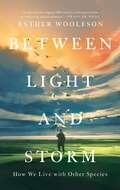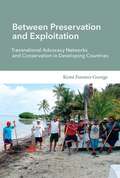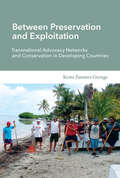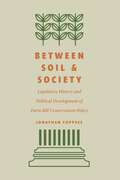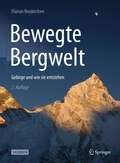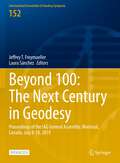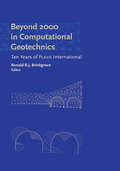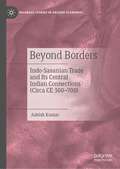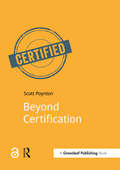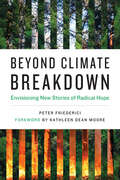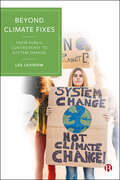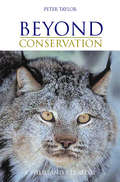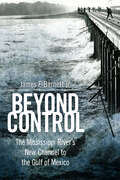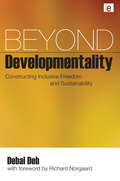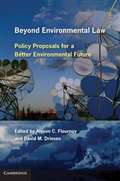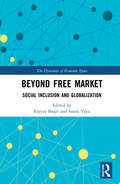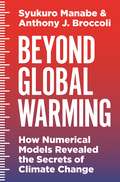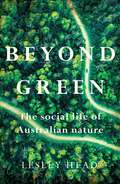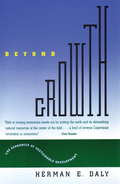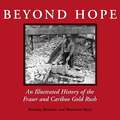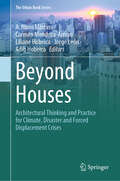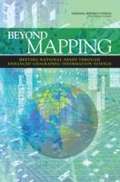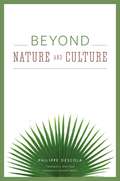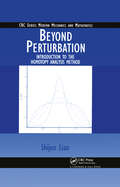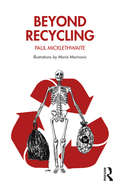- Table View
- List View
Between Light and Storm: How We Live with Other Species
by Esther WoolfsonA landmark examination of the fraught relationship between humans and animals, taking the reader from Genesis to climate change.Beginning with the very origins of life on Earth, Woolfson considers prehistoric human-animal interaction and traces the millennia-long evolution of conceptions of the soul and conscience in relation to the animal kingdom, and the consequences of our belief in human superiority. She explores our representation of animals in art, our consumption of them for food, our experiments on them for science, and our willingness to slaughter them for sport and fashion, as well as examining concepts of love and ownership. Drawing on philosophy and theology, art and history, as well as her own experience of living with animals and coming to know, love, and respect them as individuals, Woolfson examines some of the most complex ethical issues surrounding our treatment of animals and argues passionately and persuasively for a more humble, more humane, relationship with the creatures who share our world.
Between Preservation and Exploitation: Transnational Advocacy Networks and Conservation in Developing Countries
by Kemi Fuentes-GeorgeIn the late 2000s, ordinary citizens in Jamaica and Mexico demanded that government put a stop to lucrative but environmentally harmful economic development activities -- bauxite mining in Jamaica and large-scale tourism and overfishing on the eastern coast of the Yucatán Peninsula. In each case, the catalyst for the campaign was information gathered and disseminated by transnational advocacy networks (TANs) of researchers, academics, and activists. Both campaigns were successful despite opposition from industry supporters. Meanwhile, simultaneous campaigns to manage land in another part of the Yucatán and to conserve migratory birds in Egypt had far less success. In this book, Kemi Fuentes-George uses these four cases to analyze factors that determine the success or failure of efforts by TANs to persuade policymakers and private sector actors in developing countries to change environmental behavior. Fuentes-George argues that in order to influence the design and implementation of policy, TANs must generate a scientific consensus, create social relationships with local actors, and advocate for biodiversity in a way that promotes local environmental justice. Environmentally just policies would allow local populations access to their lands provided they use natural resources sustainably. Justice claims are also more likely to generate needed support among local groups for conservation projects.In their conservation efforts, Jamaica, Mexico, and Egypt were attempting to meet their obligations under the UN Convention on Biological Diversity and other regional agreements. Fuentes-George's innovative analysis shows the importance of local environmental justice for the implementation of international environmental treaties.
Between Preservation and Exploitation: Transnational Advocacy Networks and Conservation in Developing Countries (Politics, Science, and the Environment)
by Kemi Fuentes-GeorgeA study of biodiversity governance analyzes the factors that determine the effectiveness of transnational advocacy networks and the importance of justice claims to conservation. In the late 2000s, ordinary citizens in Jamaica and Mexico demanded that government put a stop to lucrative but environmentally harmful economic development activities—bauxite mining in Jamaica and large-scale tourism and overfishing on the eastern coast of the Yucatán Peninsula. In each case, the catalyst for the campaign was information gathered and disseminated by transnational advocacy networks (TANs) of researchers, academics, and activists. Both campaigns were successful despite opposition from industry supporters. Meanwhile, simultaneous campaigns to manage land in another part of the Yucatán and to conserve migratory birds in Egypt had far less success. In this book, Kemi Fuentes-George uses these four cases to analyze factors that determine the success or failure of efforts by TANs to persuade policymakers and private sector actors in developing countries to change environmental behavior. Fuentes-George argues that in order to influence the design and implementation of policy, TANs must generate a scientific consensus, create social relationships with local actors, and advocate for biodiversity in a way that promotes local environmental justice. Environmentally just policies would allow local populations access to their lands provided they use natural resources sustainably. Justice claims are also more likely to generate needed support among local groups for conservation projects.In their conservation efforts, Jamaica, Mexico, and Egypt were attempting to meet their obligations under the UN Convention on Biological Diversity and other regional agreements. Fuentes-George's innovative analysis shows the importance of local environmental justice for the implementation of international environmental treaties.
Between Soil and Society: Legislative History and Political Development of Farm Bill Conservation Policy
by Jonathan CoppessThe United States spends approximately $5 billion each year on federal programs designed to conserve natural resources and address the environmental consequences of modern agricultural production. Like farm policy, agricultural conservation policy is rooted in the Roosevelt administration&’s New Deal efforts of the 1930s. Farm conservation policy has waxed and waned since then, related to fluctuating economic and environmental concerns. In Between Soil and Society Jonathan Coppess traces the history and development of U.S. conservation policy, especially as it compares to and interacts with the development of farm policy. By answering questions about the differences in political support and development for these similar policy regimes, with efforts to apply legal and political theory to understand the differences, Coppess considers the implications of climate change and lessons for future policy development. One of the few books to make sense of the legal and economic analysis of agricultural conservation policy, Between Soil and Society provides a window into larger issues of American politics, governance, and policy development.
Bewegte Bergwelt: Gebirge und wie sie entstehen
by Florian NeukirchenEine geologische Berg- und TalfahrtDie Bergwelt, wie wir sie kennen, geht auf eine Vielzahl von Prozessen zurück. Florian Neukirchen erklärt diese auf leicht verständliche Weise. Er führt in einer geologischen Berg- und Talfahrt durch alle Welt und fördert so manche Überraschung zutage. Ausgezeichnete Fotos begleiten den Text und wecken Reiselust. Da viele beliebte Reiseziele detailliert erklärt werden, ist das Buch zugleich eine Art Reiseführer für Naturfreunde. Warum sind die Berge so hoch, wie sie sind? Wie kommen Hochdruckgesteine an die Oberfläche? Wie entstehen Falten und Überschiebungen? Was passiert bei einem Vulkanausbruch? Warum gibt es in den Anden große Lücken im „Feuergürtel“? Warum gibt es Berge in Norwegen, in Neuseeland oder die Tepui in Venezuela? Wie beeinflussen sich Tektonik und Klima? Und woher wissen wir das alles? Diese und viele andere spannende Fragen werden beantwortet. Das Buch stützt sich dabei auf aktuelle Erkenntnisse aus so unterschiedlichen Fachgebieten wie Plattentektonik, Tektonik, Geomorphologie, Geophysik und Petrologie. Ein Buch, das Sie mitnimmt auf eine faszinierende Reise in Welten, die alles andere sind als fest und starr – eine sich bewegende Geschichte unserer Bergwelten mit vielen Höhen und Tiefen, die sich liest wie ein spannender Krimi.
Beyond 100: Proceedings of the IAG General Assembly, Montreal, Canada, July 8-18, 2019 (International Association of Geodesy Symposia #152)
by Jeffrey T. Freymueller Laura SánchezThis open access book contains 30 peer-reviewed papers based on presentations at the 27th General Assembly of the International Union of Geodesy and Geophysics (IUGG). The meeting was held from July 8 to 18, 2019 in Montreal, Canada, with the theme being the celebration of the centennial of the establishment of the IUGG. The centennial was also a good opportunity to look forward to the next century, as reflected in the title of this volume. The papers in this volume represent a cross-section of present activity in geodesy, and highlight the future directions in the field as we begin the second century of the IUGG. During the meeting, the International Association of Geodesy (IAG) organized one Union Symposium, 6 IAG Symposia, 7 Joint Symposia with other associations, and 20 business meetings. In addition, IAG co-sponsored 8 Union Symposia and 15 Joint Symposia. In total, 3952 participants registered, 437 of them with IAG priority. In total, there were 234 symposia and 18 Workshops with 4580 presentations, of which 469 were in IAG-associated symposia.
Beyond 2000 in Computational Geotechnics
by Ronald B.J. BrinkgreveThis volume contains papers presented during the first international PLAXIS symposium. Topics covered include: general geo-technical aspects; tunnels and deep excavations, and education and research. This pack is meant for the user of the PLAXIS program, as well as engineers and researchers.
Beyond Borders: Indo-Sasanian Trade and Its Central Indian Connections (Circa CE 300–700) (Palgrave Studies in Ancient Economies)
by Ashish KumarThis book examines the economic history of ancient South Asia by situating the Malwa region of Central India within Afro-Eurasian trade networks to illuminate the role of traders in the political, religious and economic processes connected with the Indo-Sasanian trade in the period of five centuries, circa CE 300-700.The book challenges the long-held centrality of the Roman factor in the South Asian economy by locating the Indo-Sasanian interactions in long distance economic networks with trade as a central feature. It considers the role and influence of traders as an understudied group affecting the contribution of the Indian economy to the world system. Amidst rapidly changing political landscapes, traders of Indian and Sasanian origins are studied as conscious political beings, who formed ties with varieties of polities and religious communities to secure their commercial interests. In addition, their commercial interactions with their Sogdian (Central Asia) and Aksumite (East Africa) counterparts are analyzed. The book also considers the nature of trade routes and the specific connections between mercantile and religious networks, including patterns of construction of religious shrines and temples along trade routes. Integrating epigraphic, numismatic, literary and archaeological evidence, this book moves away from a marginal treatment of the Indo-Sasanian trade in Indian history, and demonstrates how regional economic history must address a plurality of causes, actors, and processes in its assessment of the regional economy. The book will be of interest to students and academics of Indian economic history, as well as the ancient economies of South Asia more broadly.
Beyond Certification (Doshorts Ser.)
by Scott PoyntonThis book is free to download in PDF and EPub formats. Is certification the solution? Can it deliver urgently needed improvements to complex problems like deforestation and the exploitation of people? In this controversial new book, Scott Poynton, founder of The Forest Trust, makes a compelling case for a new approach to social and environmental problems that goes "beyond certification".Certification emerged from the 1992 Rio Earth Summit amidst great hope. Since then, despite a proliferation of certification schemes in twenty-five industry sectors, the destructive and irresponsible exploitation of natural and human resources has grown still worse. Beyond Certification reviews the positive aspects of certification, of which there are many, but argues that we can no longer afford to gloss over its failures. The book offers an alternative model, VT-TV, based on Values, Transparency, Transformation and Verification, which the author has been exploring and implementing with over 70 companies and industries around the world. These companies are transforming the story of the raw materials they use – wood, palm oil, pulp and paper, stone, charcoal, soy, beef, sugar, dairy, rubber, coffee, cocoa and coconut. Mining companies are also exploring this approach, making decisions aligned with fundamental values and what they know to be right.The results? Trust is emerging as former combatants awake to the importance of working together. Guns have been removed from forests, land set aside for protection, worker rights and conditions improved and long-standing conflicts have been resolved as people confront their legacies. Beyond Certification does not claim that this VT-TV model is the only solution. Rather, it shows how new and seemingly radical thinking can catalyze positive change. Included: the limits of roundtable certification illustrated with real, practical examples; the intricacies of the change process – how companies move from destructive to more responsible practices; how to implement more holistic, economically effective, durable systems to better protect people and the environment.
Beyond Climate Breakdown: Envisioning New Stories of Radical Hope (One Planet)
by Peter FriedericiThe importance of telling new climate stories—stories that center the persistence of life itself, that embrace comedy and radical hope.&“How dare you?&” asked teenage climate activist Greta Thunberg at the United Nations in 2019. How dare the world&’s leaders fiddle around the edges when the world is on fire? Why is society unable to grasp the enormity of climate change? In Beyond Climate Breakdown, Peter Friederici writes that the answer must come in the form of a story, and that our miscomprehension of the climate crisis comes about because we have been telling the wrong stories. These stories are pervasive; they come from long narrative traditions, sanctioned by capitalism, Hollywood, and social media, and they revolve around a myth: that the nation exists primarily as a setting for a certain kind of economic activity. Stories are how we make sense of the world and our place in it. The story that &“the economy&” takes priority over everything else may seem foreordained, but, Friederici explains, actually reflect choices made by specific people out of self-interest. So we need new stories—stories that center the persistence of life, rather than of capitalism, stories that embrace contradiction and complexity. We can create new stories based on comedy and radical hope. Comedy never says no; hope sprouts like a flower in cracked concrete. These attitudes require a new way of thinking—an adaptive attitude toward life that slips the narrow yoke of definition.
Beyond Climate Fixes: From Public Controversy to System Change
by Les LevidowPolitical elites have been evading the causes of climate change through deceptive fixes. Their market-type instruments such as carbon trading aim to incentivise technological innovation which will supposedly decarbonize or replace dominant high-carbon systems. In practice this techno-market framework has perpetuated climate change and social injustices, thus provoking public controversy. Using this opportunity, social movements have counterposed low-carbon, resource-light, socially just alternatives. Such transformative mobilisations can fulfil the popular slogan, ‘System Change Not Climate Change’. This book develops key critical concepts through case studies such as GM crops, biofuels, waste incineration and Green New Deal agendas.
Beyond Conservation: A Wildland Strategy
by Peter TaylorAfter decades of operating off-the-backfoot and protecting and conserving nature perceived as under threat, conservationists are becoming proactive and creative in the face of habitat loss, agricultural intensification and climate change. Beyond Conservation offers a revolutionary agenda for both managing existing wildlands in Britain and for expanding and connecting such lands. Central to this strategy is the imperative to 'rewild' or restore and repair damaged habitat and ecosystems, promote existing biodiversity and reintroduce vanished plant and animal species, while working to reconcile human needs and livelihoods and the needs of nature.
Beyond Control: The Mississippi River’s New Channel to the Gulf of Mexico (America's Third Coast Series)
by James F. Barnett Jr.Beyond Control reveals the Mississippi as a waterway of change, unnaturally confined by ever-larger levees and control structures. During the great flood of 1973, the current scoured a hole beneath the main structure near Baton Rouge and enlarged a pre-existing football-field-size crater. That night the Mississippi River nearly changed its course for a shorter and steeper path to the sea. Such a map-changing reconfiguration of the country’s largest river would bear national significance as well as disastrous consequences for New Orleans and towns like Morgan City, at the mouth of the Atchafalaya River. Since 1973, the US Army Corps of Engineers Control Complex at Old River has kept the Mississippi from jumping out of its historic channel and plunging through the Atchafalaya Basin to the Gulf of Mexico. Beyond Control traces the history of this phenomenon, beginning with a major channel shift around 3,000 years ago. By the time European colonists began to explore the Lower Mississippi Valley, a unique confluence of waterways had formed where the Red River joined the Mississippi, and the Atchafalaya River flowed out into the Atchafalaya Basin. A series of human alterations to this potentially volatile web of rivers, starting with a bend cutoff in 1831 by Captain Henry Miller Shreve, set the forces in motion for the Mississippi’s move into the Atchafalaya Basin. Told against the backdrop of the Lower Mississippi River’s impending diversion, the book’s chapters chronicle historic floods, rising flood crests, a changing strategy for flood protection, and competing interests in the management of the Old River outlet. Beyond Control is both a history and a close look at an inexorable, living process happening now in the twenty-first century.
Beyond Developmentality: Constructing Inclusive Freedom and Sustainability
by Debal DebHistory tells us that industrial development with all of its pollution, inequity and exploitation is the inevitable destiny of human societies. Yet is this really the case or are we trapped in a prevailing 'develop-mentality' that demands an endless cycle of inputs, outputs, consumption and waste on a finite planet? And is there another, better way for humans and the biosphere? This incisive, epic work turns the dominant industrial development model and its economics upside down and argues for a new way of thinking about the meaning of development and the complexion of our economy. The book traces the origin and development of the concept of development in the economic context, and suggests a way to achieving post-industrial development with zero industrial growth. The book argues that sustainable development is possible only when concerns for biodiversity and human development are put at the centre of the economy and social policy. It both provides a theoretical foundation to sustainability and presents practical instances of sustainable production systems. Coverage is magisterial and includes history, ecology, economics, anthropology, policy analysis, population theory, sociology, the Marxian critique of capitalism, Orientalism, semiotics and sociology of science. These are interwoven in an accessible but challenging way that enables readers to look at development theory, economics, consumerism and environmentalism from a new vantage point. Distinguishing features includes a critique of development from a natural science perspective, a fresh and thorough account of the concept of sustainability both from a theoretical and empirical perspective and the application of an evolutionary biology metaphor to building a socially responsible alternative to the prevailing developmentality. This is the most sweeping coverage of critical issues in economics, environment, development and sustainability available. It is both an empowering and necessary read for students, academics, professionals and activists from across sustainability, development, economics and environmental studies and beyond, and an invaluable repository of information about the critical issues facing humanity as we continue to develop our over-crowded planet.
Beyond Environmental Law
by Alyson C. Flournoy David M. DriesenThis book offers a vision for the third generation of environmental law designed to enhance its ability to protect our environment. The book presents two core proposals, an Environmental Legacy Act to preserve a defined environmental legacy for future generations and an Environmental Competition Statute to spark movement to new clean technologies. The first proposal would require, for the first time, that the federal government define an environmental legacy that it must preserve for future generations. The second would establish a market competition to maximize environmental protection. The balance of the book provides complimentary proposals and analysis. The first generation of environmental law sought broad protection of health and the environment in a fairly fragmented way. The second sought to enhance environmental law's efficiency through cost-benefit analysis and market mechanisms. These proposals seek to create a broader, more creative approach to solving environmental problems.
Beyond Free Market: Social Inclusion and Globalization (The Dynamics of Economic Space)
by Sanni Yaya Fayyaz BaqirThis book explores the causes and consequences of market failure in bridging societal differences to create a shared economy. It questions the current world order and evaluates socio-economic gains in reference to the social origins of the economic agents. With a need to counterbalance economic growth with social equality and environmental sustainability, the book proposes innovative approaches to address key questions on the contemporary global economy such as, "Is the Global socio-economic order supportive of the pursuit of rational and enlightened self -interest?", "Is it a unipolar power centre and neoliberal economic policy regime?", "Can the system reinvent itself?", etc. One approach encourages going back to the golden past and making things "great again", insisting that history has ended and the failures of old global institutions be blamed on the "Clash of Civilizations". Another approach advocates giving up the intellectual comfort zone of elegant but irrelevant neo-liberal explanations of global challenges and asking new questions that take academic debate to the public square. The book examines the internal challenges and contradictions that cause disintegration and proposes alternative ideas and practices in moving the global community beyond the free market regime. The book will appeal to students and academics of development studies, political economy, political science, sociology, as well as policymakers and public opinion makers interested in creating a new egalitarian global society.
Beyond Global Warming: How Numerical Models Revealed the Secrets of Climate Change
by Syukuro Manabe Anthony J. BroccoliA definitive account of how we have come to understand the fundamental processes behind global warmingSyukuro Manabe is perhaps the leading pioneer of modern climate modeling. Beyond Global Warming is his compelling firsthand account of how the scientific community came to understand the human causes of climate change, and how numerical models using the world’s most powerful computers have been instrumental to these vital discoveries.Joined by atmospheric scientist Anthony Broccoli, Manabe shows how climate models have been used as virtual laboratories for examining the complex planetary interactions of atmosphere, ocean, and land. Manabe and Broccoli use these studies as the basis for a broader discussion of human-induced global warming—and what the future may hold for a warming planet. They tell the stories of early trailblazers such as Svante Arrhenius, the legendary Swedish scientist who created the first climate model of Earth more than a century ago, and they provide rare insights into Manabe’s own groundbreaking work over the past five decades. Expertly walking readers through key breakthroughs, they explain why increasing atmospheric carbon dioxide has caused temperatures to rise in the troposphere yet fall in the stratosphere, why the warming of the planet’s surface differs by hemisphere, why drought is becoming more frequent in arid regions despite the global increase in precipitation, and much more.Authoritative and illuminating, Beyond Global Warming is an invaluable insider’s look at some of today’s most cutting-edge Earth science, and a rare window into a brilliant scientific mind.
Beyond Green: The Social Life of Australian Nature
by Lesley HeadHow are we to think about nature and the environment? The idea of nature as it relates to culture, society and humans has always been in constant flux and highly contested. Lesley Head interrogates the ways the cultures of nature have operated in Australia across time, and how these ways of thinking and being limit our capacity to deal with the challenges of the climate change and biodiversity crises. Drawing on her life&’s work and lessons she has picked up along the way, Head suggests that it is up to us to attentively listen, the better to destabilise and subvert dominant narratives, and to imagine new possibilities. She believes we have the nous, resources and lessons from Indigenous, settler-descendant and immigrant cultures to reduce risk in the face of the unexpected and the unimaginable. In Beyond Green, the story of nature and people weaves research and personal experience through many different times and spaces, offering new ways of understanding. It is a richly creative engagement with the abundant possibilities and pleasure of nature as a place of regeneration that is as warned by the rawk of the crow as it is accompanied by the carolling of magpies.
Beyond Growth
by Herman E. Daly"Daly is turning economics inside out by putting the earth and its diminishing natural resources at the center of the field . . . a kind of reverse Copernican revolution in economics." --Utne Reader"Considered by most to be the dean of ecological economics, Herman E. Daly elegantly topples many shibboleths in Beyond Growth. Daly challenges the conventional notion that growth is always good, and he bucks environmentalist orthodoxy, arguing that the current focus on 'sustainable development' is misguided and that the phrase itself has become meaningless."--Mother Jones"In Beyond Growth, . . . [Daly] derides the concept of 'sustainable growth' as an oxymoron. . . . Calling Mr. Daly 'an unsung hero,' Robert Goodland, the World Bank's top environmental adviser, says, 'He has been a voice crying in the wilderness.'" --G. Pascal Zachary, The Wall Street Journal"A new book by that most far-seeing and heretical of economists, Herman Daly. For 25 years now, Daly has been thinking through a new economics that accounts for the wealth of nature, the value of community and the necessity for morality." --Donella H. Meadows, Los Angeles Times"For clarity of vision and ecological wisdom Herman Daly has no peer among contemporary economists. . . . Beyond Growth is essential reading."--David W. Orr, Oberlin College"There is no more basic ethical question than the one Herman Daly is asking." --Hal Kahn, The San Jose Mercury News"Daly's critiques of economic orthodoxy . . . deliver a powerful and much-needed jolt to conventional thinking." --Karen Pennar, Business WeekNamed one of a hundred "visionaries who could change your life" by the Utne Reader,Herman Daly is the recipient of many awards, including a Grawemeyer Award, the Heineken Prize for environmental science, and the "Alternative Nobel Prize," the Right Livelihood Award. He is professor at the University of Maryland's School of Public Affairs, and coauthor with John Cobb, Jr., of For the Common Good.
Beyond Hope: An Illustrated History of the Fraser and Cariboo Gold Rush
by Beverley Boissery Bronwyn ShortGold. With that one little word and its promise of fabulous wealth, people from all parts of the world came to British Columbia in the 1850s and 1860s. Most were ill equipped for the difficult terrain, the icy water, and the inhospitable climate. Some found the motherlode. Others settled for becoming rich merchants. Most became impoverished, and a large number lost their lives. With new roads and new settlers, the gold rush helped build Canada’s West. This pictorial history tells the stories of the Fraser and Cariboo gold rush and of the lives involved in that tumultuous but decisive event in Canadian history.
Beyond Houses: Architectural Thinking and Practice for Climate, Disaster and Forced Displacement Crises (The Urban Book Series)
by A. Nuno Martins Carmen Mendoza-Arroyo Liliane Hobeica Jorge León Adib HobeicaThis book delves into the complexities of urban crises, focusing on the efforts of researchers and practitioners who confront precarious housing and forced displacement. Originating from the 8th International Conference on Building Resilience (convened in November 2018 in Lisbon, Portugal), this book examines challenges across diverse contexts and geographies, including Chile, India, Kenya, Mexico, Portugal, and Syria. Structured in three parts, the book's 12 chapters address disaster prevention and recovery, humanitarian architecture, and issues related to housing, migration, and urban forced displacement. The narratives emphasize vulnerabilities, community-driven design, and cross-cultural perspectives, comprehensively reviewing global urban planning, slum upgrading, and incremental housing strategies. The contributions engage readers with practical insights for mitigating urban vulnerability and intellectual analyses that consider the complexities of life amid systemic injustices. Ultimately, the authors suggest integrating architectural practice with social work within communities to address intricate urban housing challenges.
Beyond Mapping: Meeting National Needs Through Enhanced Geographic Information Science
by National Research Council of the National AcademiesGeographic information systems (GIS), the Global Positioning System (GPS), remote sensing, and other information technologies have all changed the nature of work in the mapping sciences and in the professions, industries, and institutions that depend on them for basic research and education. Today, geographic information systems have become central to the ways thousands of government agencies, private companies, and not-for-profit organizations do business. However, the supply of GIS/GIScience professionals has not kept pace with the demand generated by growing needs for more and improved geographic information systems and for more robust geographic data. Beyond Mapping assesses the state of mapping sciences at the beginning of the twenty-first century and identifies the critical national needs for GIS/GIScience professionals. It examines the forces that drive and accompany the need for GIS/GIScience professionals, including technological change, demand for geographic information, and changes in organizations. It assesses education and research needs, including essential training and education, new curriculum challenges and responses, quality assurance in education and training, and organizational challenges. Some of the report's recommendations include more collaboration among academic disciplines, private companies, and government agencies; the implementation of GIS/GIScience at all levels of education; and the development of a coherent, comprehensive research agenda for the mapping sciences.
Beyond Nature and Culture
by Philippe DescolaPhilippe Descola has become one of the most important anthropologists working today, and Beyond Nature and Culture has been a major influence in European intellectual life since its French publication in 2005. Here, finally, it is brought to English-language readers. At its heart is a question central to both anthropology and philosophy: what is the relationship between nature and culture? Culture--as a collective human making, of art, language, and so forth--is often seen as essentially different from nature, which is portrayed as a collective of the nonhuman world, of plants, animals, geology, and natural forces. Descola shows this essential difference to be, however, not only a specifically Western notion, but also a very recent one. Drawing on ethnographic examples from around the world and theoretical understandings from cognitive science, structural analysis, and phenomenology, he formulates a sophisticated new framework, the "four ontologies"-- animism, totemism, naturalism, and analogism--to account for all the ways we relate ourselves to nature. By thinking beyond nature and culture as a simple dichotomy, Descola offers nothing short of a fundamental reformulation by which anthropologists and philosophers can see the world afresh.
Beyond Perturbation: Introduction to the Homotopy Analysis Method (Modern Mechanics and Mathematics)
by Shijun LiaoSolving nonlinear problems is inherently difficult, and the stronger the nonlinearity, the more intractable solutions become. Analytic approximations often break down as nonlinearity becomes strong, and even perturbation approximations are valid only for problems with weak nonlinearity. This book introduces a powerful new analytic method for nonlinear problems-homotopy analysis-that remains valid even with strong nonlinearity. In Part I, the author starts with a very simple example, then presents the basic ideas, detailed procedures, and the advantages (and limitations) of homotopy analysis. Part II illustrates the application of homotopy analysis to many interesting nonlinear problems. These range from simple bifurcations of a nonlinear boundary-value problem to the Thomas-Fermi atom model, Volterra's population model, Von Karman swirling viscous flow, and nonlinear progressive waves in deep water. Although the homotopy analysis method has been verified in a number of prestigious journals, it has yet to be fully detailed in book form. Written by a pioneer in its development, Beyond Pertubation: Introduction to the Homotopy Analysis Method is your first opportunity to explore the details of this valuable new approach, add it to your analytic toolbox, and perhaps make contributions to some of the questions that remain open.
Beyond Recycling
by Paul MicklethwaiteBeyond Recycling critically explores unasked questions around recycling and its prominent position in contemporary thinking about sustainability. It examines and challenges assumptions about why we appear to have so wholeheartedly committed to recycling as a cultural project. Recycling has become a commonplace notion and widespread practice. Yet its social, cultural and even environmental value has not been considered carefully enough. This book considers recycling as a contemporary cultural idea related to – but not wholly defied by – our response to material waste. It seeks to reclaim recycling from the environmentalists and waste management specialists, to explore the role it plays in wider contemporary discourse. As we become increasingly satiated, and in many cases sickened, by the excesses of modern consumerism, we are rethinking our relationship with the physical stuff that fills our lives. Dissatisfied with empty materialism, we seek new ways to reuse our material culture. Recycling, turning something considered to be waste into something with renewed value, is our primary collective response to the problems arising from consumption; and it is ripe for critical examination. Beyond Recycling is a fascinating read for conscious consumers and students in the creative arts, design, cultural studies, sustainability and environmental studies.
